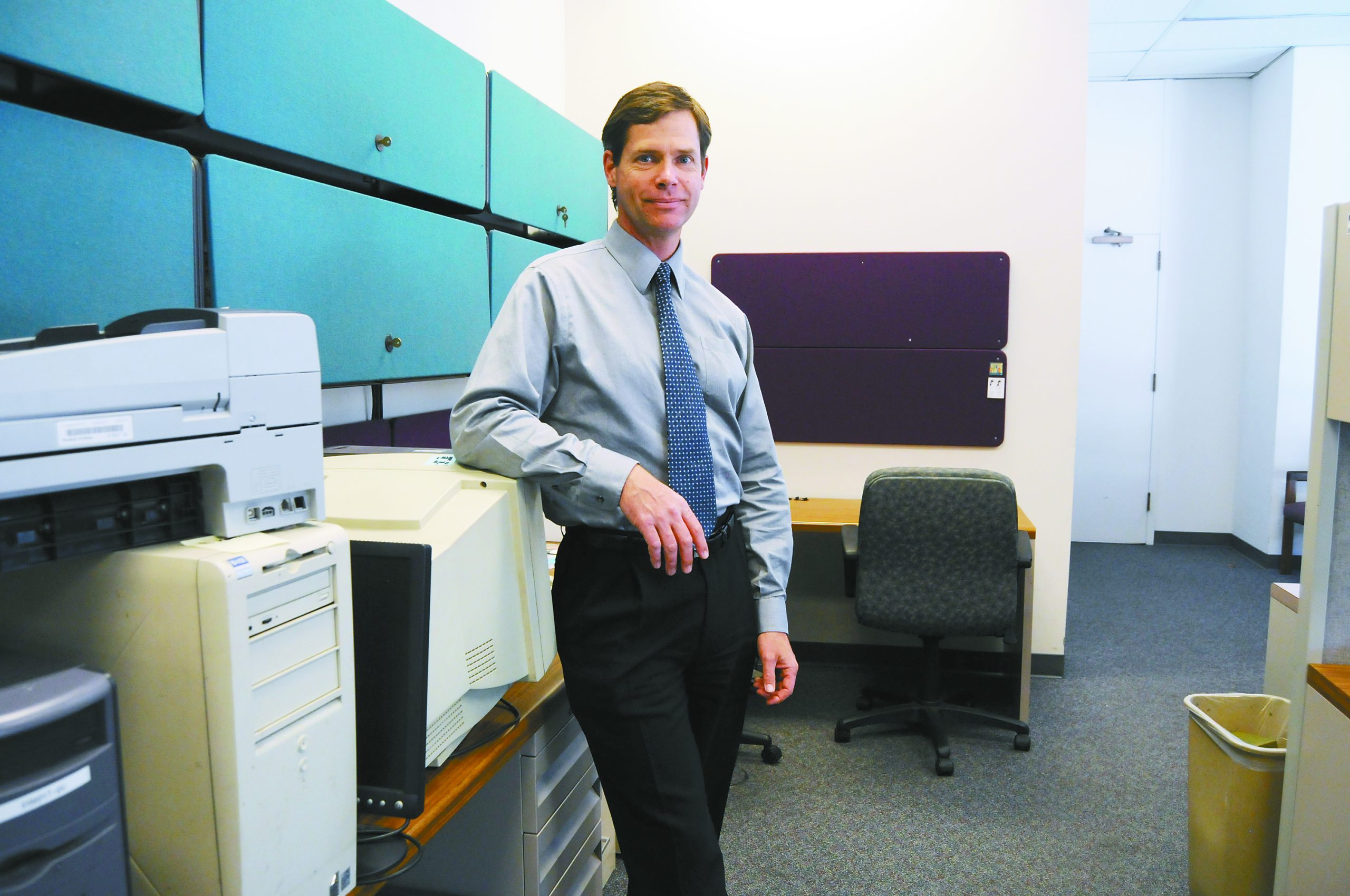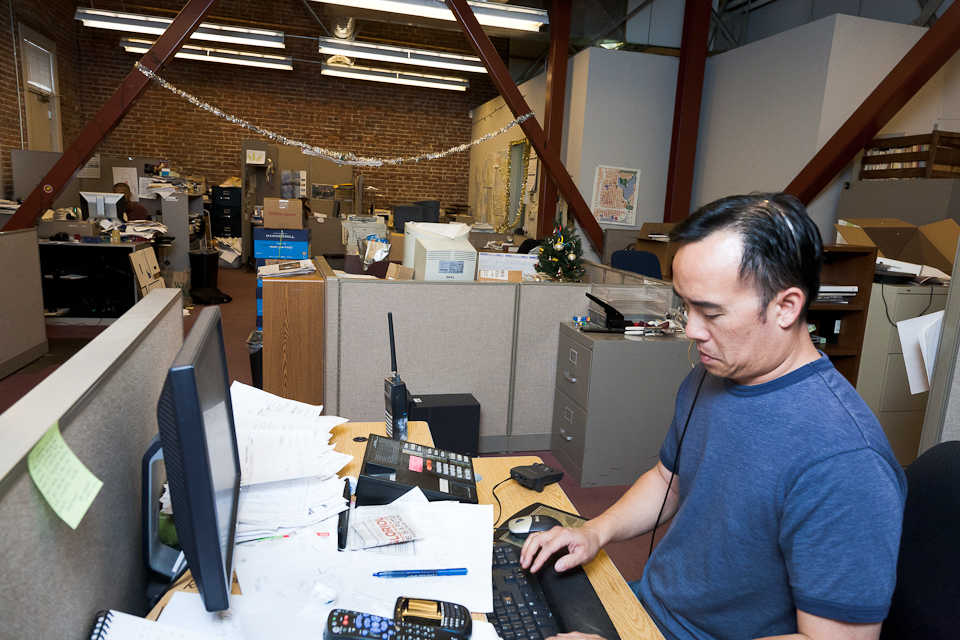BYGONE BUREAUS: 8 of 9 local offices of the San Francisco Chronicle shuttered in last decade
Most days, before his alarm clock goes off at 5 a.m., Henry K. Lee’s Blackberry wakes him, dinging with texts and email breaking-news alerts.
As one of two remaining San Francisco Chronicle Bay Area bureau reporters, he has his work cut out for him.
Lee quickly switches on three TVs in his house in Oakland, scans a few websites and flips through local newspapers for crime tidbits. He rarely has time for breakfast.
That was his predawn routine the first Friday in May, when he fast-forwarded through the overnight newscasts saved on TiVo to learn that a pedestrian was killed by a suspected hit-and-run drunk driver at Masonic Avenue and Turk Street in San Francisco.
The 17-year veteran reporter had no time to cross the bridge and visit the crime scene. In his one-man “maniac rush to beat the competition,” he had to settle for desk work: He searched for a license plate number, identified which cops were on the investigation and called the medical examiner. By 9 a.m. — two hours after he slid into the nearly empty downtown Oakland bureau — the story was already up on SFGate.com.
No time to stop. By the time he clocked out at 3:30 p.m., he’d written three more stories, all about East Bay crimes. Trudging back home, he reset his TiVo, letting the TV news crews chase the ambulances for him.
Life in the Chronicle’s bureaus wasn’t always so frenetic. In 2000, there were 32 reporters stationed in nine Bay Area bureaus across four counties, producing five zoned local editions each morning.
Now just two bureau reporters, Lee and East Bay columnist Chip Johnson, remain in one office in Oakland that once accommodated nine. All the other satellite offices have shut down, most between 2005 and 2009, leaving Lee to cover breaking news (mostly crime) from Santa Rosa in the north to San Jose in the south to Pittsburg way out east — hundreds of square miles.
Stephen Proctor, the Chronicle’s managing editor, defended the paper’s actions. He said that in light of revenue shortfalls and significant reductions in staffing, the paper still prioritizes investigative and enterprise work.
“We’re focusing on what we consider to be the key topics that unite the Bay Area, such as technology, real estate, the environment, food and wine, and transportation, as opposed to focusing on individual communities,” Proctor said.
He said the Chronicle’s coverage of the pipeline explosion that devastated the Crestmoore neighborhood of San Bruno last fall is a good example of the Chronicle’s best work.
“It’s unfair to single out the Chronicle,” he said. “Newspapers across the nation have had to make significant reductions to staff.”
The newspaper’s retreat from the suburbs came in the wake of massive layoffs and buyouts of reporters and editors also starting in 2005. Outside the Bay Area, just two bureaus remain — two warm bodies in Sacramento and one person in Washington, who shares a small office with the Hearst capital bureau.
The Chronicle once boasted local sections custom written for San Francisco, the Peninsula, Contra Costa, the East Bay and the North Bay.
But as suburbanites canceled their subscriptions by the tens of thousands, the remaining journalists were recalled to headquarters in San Francisco, where the editorial staff has shrunk to 140 from a peak of about 560 a decade ago, said Carl Hall, head of the regional newspaper union.
In a series of interviews, current and former Chronicle staffers said that managers, realizing something had to give as advertising losses led the paper to bleed millions of dollars per week, set about restructuring the newsroom to focus on what it knew best — the city of San Francisco, plus sports and the arts.
Most of the Chronicle staff and alumni interviewed said the result is tangibly diminished depth of news coverage, as reporters are pressed to produce more stories and cover more geography.
Shorter articles, fewer sources. More spot news, less investigation.
Once helped solve a murder
Lee’s office is desolate. He’s often the only reporter in the room. A mini Christmas tree is decked out in an empty cubicle littered with yellowing newspapers and government reports. Disconnected old computers and TVs are pushed out of sight.
It wasn’t supposed to be this way. During the Chronicle’s heyday of the late 1990s and early 2000s, the paper launched ambitious plans to expand into the suburbs and outlying cities. The strategy to actively compete with other major dailies largely owned by the MediaNews Group ended with the Chronicle’s financial implosion: By 2009 the Hearst Corp. was reporting losses of at least $52 million a year. The privately held New York–based company attributed the losses to the advent of Internet job listings, the loss of classified advertising and slackening newsstand sales.
“The beefed-up coverage in the East Bay was pulled back because we were losing so much money,” Lee said. “I guess we’re doing more with less. We’re trying to cover it all, but we can’t do it with as many details as we’d like to.”
Between September 2006 and December 2008, Lee was freed up to write 200 articles and live blog posts on a murder in Oakland. The coverage unearthed previously unseen documents in the investigation that led to the arrest and conviction of Hans Reiser, whose estranged wife, Nina, had been reported missing. Reiser would later admit to strangling her. That coverage won Lee a book contract.
Lee’s stories nowadays are often short and often colorfully written, but he’s rarely allowed to go into a big story in depth. The first Friday in May, his story in the morning paper exalted the tiny: “Chihuahua survives 4-alarm fire in SoMa.”
That week, Lee wrote 18 stories. Topics included a proposed gang injunction in Oakland, a gang trial in Daly City and a parolee who allegedly fired shots at a police officer in Pittsburg.
“I think the impact is we don’t have time to do the long investigative pieces that were more common back in the day,” agreed Peter Fimrite, who has worked for the Chronicle for 21 years, and worked both the San Rafael and Oakland bureaus.
“It’s too bad,” he said. “People who are knowledgeable about particular areas and civic organizations are not there anymore. So when we do cover things outside San Francisco, the reporters often have to learn everything anew. So, yes, I think it hurts.”
Media outlets abandon Peninsula
Marshall Wilson remembers a time at the Chronicle when management could afford to let reporters take time off to do investigative stories. He was hired in 1996 and assigned to the Peninsula bureau in Redwood City because he had extensive knowledge of the area. He grew up there and covered the county for what was then called The San Mateo Times.
“Every story was a battle with the Mercury News — we were at war,” Wilson said. “The Chronicle didn’t want three or four stories a day — they wanted the best story of the day. We had to work harder, produce better work and write better than the competitor did.”
But the newsroom culture did not survive the paper’s retrenchment. After he quit in 2006 and the bureau subsequently closed, he switched teams, getting a job doing public relations for the county.
The press office on the first floor of the county offices used to be so packed that police and politicians could walk in and give a press conference. No longer. Most days there is just one reporter there, and he works for a wire service whose dispatches go to dozens of news organizations.
Robert Gunnison, a professor at U.C. Berkeley’s Graduate School of Journalism, said it’s not the Chronicle’s fault that coverage and readership has declined. In 2000 the paper boasted a circulation of around half a million copies daily. As of May, weekday circulation was 235,350, a 2.5 percent decline over the past year, according to the Audit Bureau of Circulations, an industry association that tracks newspaper readership and demographics.
The paper put the best gloss on the story it could in a short, unbylined article on the front of the business section: “Chronicle sees gains in Sunday circulation.” It rose 2.2 percent, to 292,459. The article did not mention the daily paper’s decline.
The Mercury News also tried to spin otherwise depressing numbers. In a bit of mathematical gymnastics, the audit bureau now uses a new accounting system that groups regional corporate clusters of papers. It now pegs the Mercury News at a gargantuan 577,665 papers daily, which “places it behind only the Los Angeles Times, New York Times, USA Today and the Wall Street Journal.”
Turns out, that’s only if you add in all the papers that the Merc’s parent company, the Bay Area News Group — a subsidiary of the Denver-based MediaNews Group — has consolidated and homogenized in the last five years. These include the Contra Costa Times, Oakland Tribune, San Mateo County Times, Marin Independent Journal, Santa Cruz Sentinel, Vallejo Times-Herald and the Vacaville Reporter.
Gunnison, a former Chronicle Sacramento bureau chief, said Craigslist’s free local classifieds took a major toll on newspaper advertising, directly resulting in the mass layoffs and buyouts. When the Chronicle stopped engaging its readers, he said, new media — including scores of online startups — flooded the market.
“Everything about the news model has changed,” he said. “Technology happened, and people there never saw it coming. The Chronicle is another paper that’s scrambling to figure it out. But it’s not unique.”

Forty-six individuals donated a total of more than $1,000 to help make possible a special report on changes in media in the Bay Area via the journalism micro-funding website Spot.Us.
This story appeared in the spring print edition as part of the Public Press’ media package of stories.
* * *
CORRECTION — 6/21/11: There appear to be more reporters based at the Chronicle’s Oakland bureau than originally reported, though exactly how many is hard to determine because some work part time, and others work primarily out of the downtown San Francisco office. Audrey Cooper, the paper’s metro editor, said that the staff list on the Chronicle’s website, which identified only two reporters as being based at the Oakland bureau, was incorrect. She said said that at least three other reporters cover the East Bay regularly or part time and count that office as their base of operations.
EDITORS’ NOTE — 6/7/11: An editor at the San Francisco Chronicle called the Public Press to request several corrections. Upon review we thought it important to answer those concerns but not correct the story.
Regarding the number of bureaus in operation, the editor mentioned that in addition to the Oakland bureau, the Chronicle has offices at San Francisco City Hall and the Hall of Justice, which we did not count as regional bureaus because they are in San Francisco. The editor also pointed out that there is a similar part-time office in the Marin courts pressroom. Because no reporter is listed as assigned to the office, we did not count this as a full-time regional news bureau.
Regarding staffing in the Oakland bureau, there is some debate within the Chronicle about who counts as bureau staff. The editor who called said Carolyn Jones and Demian Bulwa, among others who cover the East Bay, ought to count. Yet according to bureau staffer Henry K. Lee, only he and columnist Chip Johnson are full-time bureau staff. The Chronicle’s staff list online lists only Lee and Johnson at the Oakland bureau. In an interview before publication in mid-May, Managing Editor Stephen Proctor said that information was correct.
The editor raised other concerns about the tone of the piece that we felt were matters of interpretation or word choice. The editor argued that Lee is “allowed” to do bigger stories but chooses not to. The editor also said Lee is frenetic not because he is overburdened with assignments but because it is in his nature to work hard. She pointed to story counts that have been high throughout Lee’s tenure.
Lastly, the editor pointed out that the 600 employees at the Chronicle, as a result of the merger with the staff of the San Francisco Examiner, was artificially high.
We invite the Chronicle’s editors to comment further in this space.










